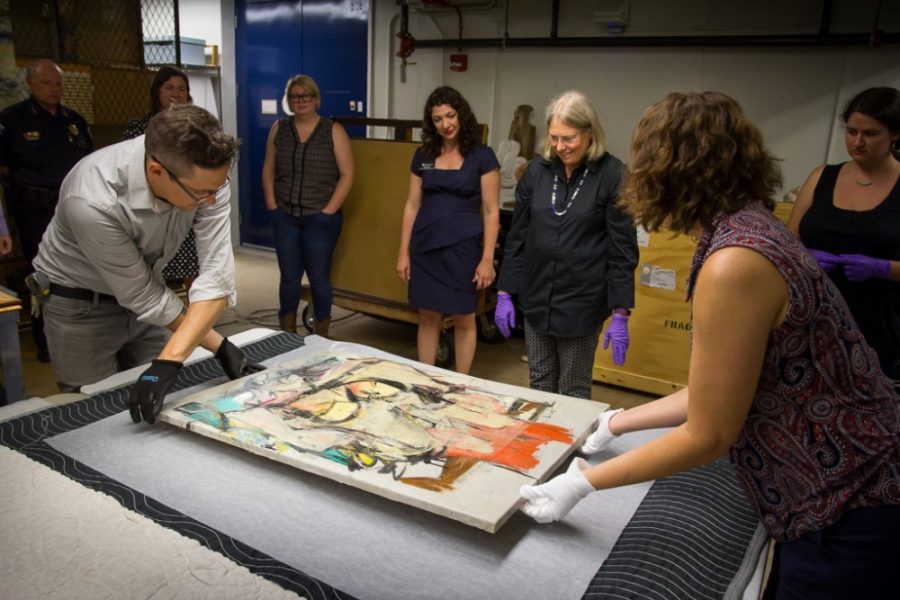The story of the stolen “Woman-Ochre” painting and its journey back to the University of Arizona Museum of Art over 30 years later sounded like it came straight from a mystery movie. Aaron Cargile decided to make that idea a reality.
Cargile, a UA film and television student, has been directing a documentary centered around the theft of the Willem de Kooning painting. He will be debuting a portion of the film at “I Dream in Widescreen” in May, as part of the School of Theatre, Film & Television senior capstone.
“What I loved about this story was that it had a magical quality about it,” Cargile said. “You have this painting that disappears, and like 95 percent of art that is stolen is never recovered. And this painting was recovered miraculously by these antique dealers. I started to piece it together and realized that really this story was one of the great American true crime stories.”
“Woman-Ochre” was originally stolen from the UAMA in 1985 and wasn’t recovered until August 2017, when it was found in an estate sale in New Mexico.
In an article published earlier by the Daily Wildcat, Olivia Miller, the curator of exhibitions for the UAMA said, “This painting has been gone for 30 years and it has missed out on 30 years of scholarship. The best we can do is turn this horrible theft into a learning opportunity.”
Cargile said he was inspired to bring this story to the big screen because of the captivating story that comes with the painting.
“This painting has brought so many people together in its story of the recovery, whether it was the whereabouts of the painting in that 30-year period or whether it was about the story of the antique-store owner who bought it for a couple hundred dollars,” Cargile said. “It’s been a really incredible story.”
RELATED: One year later: The recovery of the stolen Woman-Ochre
With a project as big as this, Cargile said he couldn’t do it all alone. Reed Chandler, the co-producer of the documentary, acts as the overseer of the project, making sure all the tasks are done in a timely fashion.
“As producer, you make a timeline for all of the project goals, you facilitate a lot of meetings, you help with any funding, you help create the budget and you help lock in all of the crew for any filming that happens,” Chandler said. “It also includes helping Aaron and honing in on the creative vision that he wants.”
Brittney Olsen, the other producer for the film, also helps make sure everyone is doing their jobs.
“When we shot reenactments last month, I helped put the crew together and make sure that Reed had what she needed to cast the film appropriately,” Olsen said.
Cargile said the documentary’s crew consists of current students and UA alumni.
“I think we have some of the best talent in Tucson working on it,” Cargile said.
From doing research to filming, the process of making the documentary has been a long, yet satisfying experience for Cargile and his crew, Cargile said.
“Before any camera roll, we had to do an intense amount of research,” Cargile said. “We had to look up everything that was publicly available about the painting, about the town it was found in and about the people whose house the painting was in.”
After doing research and visiting Silver City, N.M., where the painting was recovered, Cargile and his crew moved on to conducting interviews and filming reenactments.
RELATED: Arizona State Museum open house brings the past to the present
“We started building these relationships, did our research and did our interviews, from there we went on to staging the reenactments,” Cargile said. “It’s been a very long and hard but rewarding process.”
Even though Cargile has been working on this documentary for about a year now, he said his work is never done. He still has a couple things to polish before the finished product premieres.
“Whenever you make a documentary you are always shooting and always editing, so we are still shooting and still editing,” Cargile said. “We are very far along, and a lot of interviews are in the can. We are just trying to continue to build the story.”
While the process of making the documentary has been rewarding for Cargile and his crew, everything is not always roses, he said. One of the biggest challenges they faced was the lack of funding.
“Films do cost money,” Chandler said. “Regardless of the resources that the film and television school does give you, you still have to pay your crew, sometimes you have to pay a location fee, and you have to pay actors.”
Another challenge they faced along the way was time, Chandler said.
“You’re dealing with reality and real people, so you got to try and find these ways to build those relationships with the subjects,” Cargile said.
The making of the documentary has let the crew bond, Olsen’s favorite part of the film, she said.
“My favorite part of this documentary has been working with my team,” Olsen said. “I think Aaron is an extremely visionary director, and Reed is exactly what I need as a co-producer.”
Cargile credits the unraveling of the mystery as his favorite part of making the film.
“One of the coolest things is when you’re learning about the story and you’re with these real people who were actually involved and you get to talk to them and step into their lives a little bit,” Cargile said.
Other than being excited to see the movie at “I Dream in Widescreen,” Chandler said he is looking forward to the next steps.
“I’m looking forward to what comes after,” Chandler said. “I feel like a lot of documentaries have the opportunity to be expanded on, so I’m looking forward to expanding on this story and seeing if we can do anything else with it.”
Follow Jamie Donnely on Twitter









